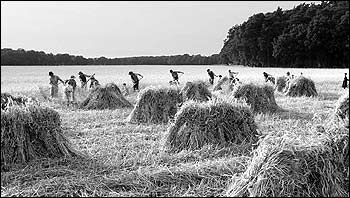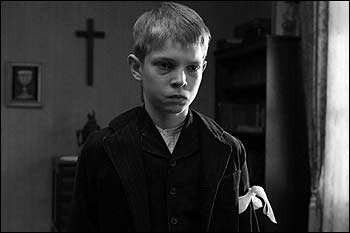
MOVIE REVIEW ARCHIVE | THEATER INFO | MOVIE LISTINGS
Child’s Play
What’s wrong with the children?
by Jason Blair
THE WHITE RIBBON: Written and directed by Michael Haneke. Cinematography, Christian Berger. Starring Christian Friedel, Ulrich Tukur and Josef Bierbichler. Sony Pictures Classics, 2009. R. 144 minutes.. ![]()
 |
 |
The White Ribbon begins with an accident. In the German village of Eichwald, in the year 1913, a doctor and his horse tumble violently to the ground, the victims of a wire strung taut across the road. By itself, the incident is more mysterious than sinister, but further disturbances follow, each clandestine act (a ruined garden, a burned barn) more audacious than the last. Someone is sabotaging the leaders of the village — the baron, the doctor and the priest, all cruel in their own fashion — raising the question of whether the victims have earned their punishment. No one ever sees or hears anything, but the children gather rather than scatter, like an organism of evil.
The night of the doctor (Rainer Bock)’s accident, the priest (Burghart Klaußner) addresses his children seated at the dinner table. Two of them have committed the mortal sin of arriving to supper a few seconds late, earning them a lecture, first, and then a thrashing to within inches of their lives. All the while, their faces are so innocent they make you shudder. In The White Ribbon, the apples don’t fall far from the tree — the strength of the film is that the fruit, while prematurely rotten, is mostly kept out of view. The White Ribbon is a graceful and artful horror movie whose horrors are entirely psychological, its violence hinted at rather than depicted, as well as a movie about children in which the onscreen events are completely taken up by adults behaving deplorably.
Narrated by the village schoolteacher (Christian Friedel) many years after the film’s events, The White Ribbon, although outwardly a thriller, is actually a great deal more than that. Presented in pristine black and white, it cloaks the identity of its perpetrators but raises less conventional questions, such as whether violence leads only to more violence, and thus whether vengeful acts can ever be justified. Is bullying a precursor to terrorism? Are the offspring of violence inherently violent? The material sounds brutal, yet while White Ribbon’s themes are indeed malice and revenge, the film is a placid, perfectly paced masterpiece. There’s a difference between a reliance on violence and an authentic attempt to understand it.
Filled with stunning photography, including snow so white you’ll blink from the glare, The White Ribbon runs well over two hours but feels much shorter. The only real weakness is the feeble way it hints, in the opening moments, that the events depicted “could perhaps clarify some things that happened in this country.” In other words, writer/director Michael Haneke is suggesting that a village of outwardly pious, inwardly malicious teens might possess the strain of hatred which metastasized during wartime — a reach that is aesthetically and morally weak-kneed. A film cannot be at once so vague and mysterious as to be allegorical and yet make claims to being an antecedent to the atrocities of WWII. Beyond that small and isolated complaint, The White Ribbon should be seen and discussed and re-seen and discussed again. It contains multitudes.
The White Ribbon opens Friday, March 12, at the Bijou